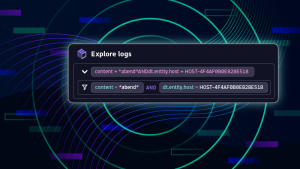Traditional log management solutions require so much manual effort to make log data valuable. A modern log management solution enables teams to analyze application performance in a more automated way.
As organizations grow, cloud application environments create complexity that makes managing and analyzing log data difficult. A traditional log management solution uses an often manual and siloed approach, which limits scalability and ultimately hinders organizational innovation.
“Traditional monitoring approaches worked fine when an operator was tasked with tracking a simple, static system,” wrote Ali Siddiqui in “How to harness the power of observability, AIOps and automation.” But, he continues, ” Today’s environments present a completely different picture. In this type of environment, it’s difficult to apply traditional monitoring, virtually impossible to keep it consistently current, and it’s challenging to get the outputs you need to truly understand performance.
To stay ahead of the curve, organizations should focus on strategic, proactive innovation and optimization. They need to automate manual tasks, streamline processes, and invest in new technologies. By doing so, they can improve efficiency, reduce costs, and deliver better customer experiences.
Traditional log management solution challenges
Survey data suggests that teams need a modern approach to log management and analytics, which requires a unified log management solution.
According to Verified Market Reports, global log management market is expected to grow at a compound annual growth rate of 10.7% during 2021–2026. And according to 451 Research, 83% of organizations plan to adapt their monitoring process.
Unlike traditional log management, which can perpetuate manual work and data silos, a more scalable approach is to use a unified log management solution that automatically retains the context of events and dependencies throughout even the most complex enterprise.
This helps to ensure that all logs are collected and stored in a single location, in context, making it easier to access and analyze them. Additionally, a unified log management solution can help to automate many of the tasks associated with log management, such as correlation and analysis. This can free up time for teams to focus on other tasks, such as troubleshooting and root-cause analysis.
With a modern approach to observability, a log management solution becomes hassle-free and automated, but also makes it easy to do exploratory analytics (that is, where teams investigate and analyze data for better decision making), collaborate securely on data-driven insights, and proactively optimize mission-critical operations and application environments.
A modern log management solution and approach
Log management is undergoing a revolution. This revolution is creating transparency and holistic thinking, while eliminating finger-pointing. Additionally, it’s providing a number of business benefits, including the following:
- Create greater organizational agility. Organizations can be more agile when they have access to real-time data about their IT infrastructure. This data can help identify and resolve issues more quickly, which can lead to faster time to market for new products and services.
- Free IT teams to focus on and support product innovation. When IT teams move from manual log management tasks, they can focus on more strategic work, such as product innovation and optimizing infrastructure. This helps organizations to stay ahead of the competition.
- Reduce costs and inefficiencies. Cloud-based log management technologies reduce total cost of ownership. These solutions often provide better scalability and performance than on-premises solutions, while still providing broad infrastructure coverage.
- Modernization brings competitive advantage. Organizations that modernize their log management practices can gain a competitive advantage. They can collect, retain, and analyze higher-quality, enriched data, which leads to better decision making and precise action.
- Future-proofing for organizational success and resilience. Organizations that future-proof their log management practices are better equipped to adapt and scale their processes to their expanding dynamic, multicloud, and distributed architectures, and they can proactively address the risks that hinder long-term success.
Dynatrace for unified, AI-powered log management and analytics
Dynatrace enables teams to analyze logs, metrics, and events in the context of traces, topology, and user sessions, with no schemas or storage tiers to manage.
Teams can instantly access petabytes of data without needing to reconstitute and reindex data from cold archives.
Dynatrace Log Management and Analytics provides a unified and comprehensive log management solution. It helps teams gain deeper insights into an application’s logs, identify issues quickly, and improve an application’s performance.
With Dynatrace, organizations can collect and store all an application’s logs in a single location. The platform makes it easy to search, filter, and analyze logs using powerful querying capabilities. Teams can also create custom dashboards and reports to visualize log data and gain insights into an application’s performance.
Dynatrace rivals the competition by providing a unified approach to data collection and analysis, powered by AI. Log Management and Analytics provides a comprehensive log management solution that helps teams gain deeper insights into application logs, identify issues quickly, and improve application performance.





Looking for answers?
Start a new discussion or ask for help in our Q&A forum.
Go to forum